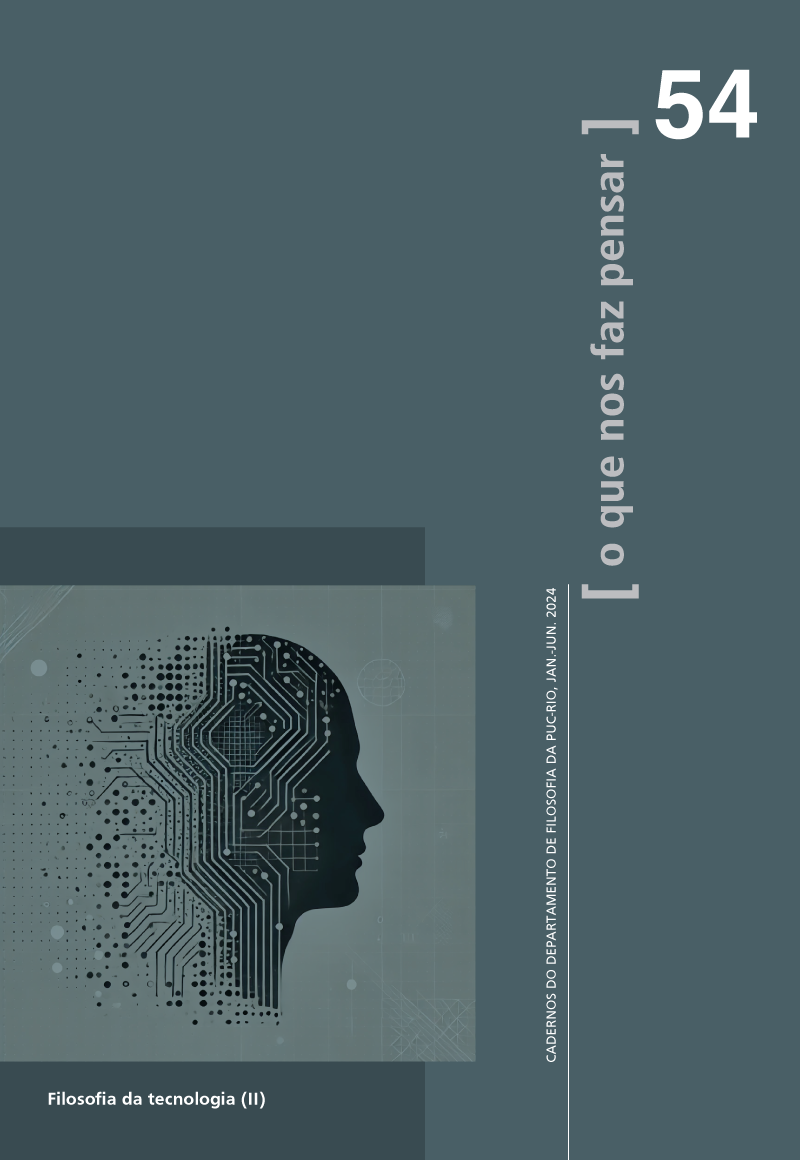Technicity and Actor-Network Theory (ANT): perspectives to investigate the impact of Artificial Intelligence on Society
Main Article Content
Abstract
The research agenda that investigates the interaction of humans with artificial intelligence (AI) has gained prominence with the popularization of tools such as ChatGPT, Gemini and Midjourney. This article proposes an introductory, exploratory and theoretical discussion about the limitations of traditional sociology to investigate the problem of non-human actors. At the same time, the text presents a literature review on the basic concepts surrounding the advent of artificial intelligence. Finally, the article discusses a theoretical framework based on Bruno Latour’s Actor-Network Theory (ANT), together with Gilbert Simondon’s technicity,
as a consistent research approach to study the interaction of users and intelligent algorithms, both human and non-human.
Article Details

This work is licensed under a Creative Commons Attribution-NonCommercial 4.0 International License.
Copyright Notice
The author of the article or book reviews submitted and approved for publication authorizes the editors to reproduce it and publish it in the journal O que nos faz pensar, with the terms “reproduction” and “publication” being understood in accordance with the definitions of the Creative Commons Attribution-NonCommercial 4.0 International license. The article or book reviews may be accessed both via the World Wide Web – Internet (WWW – Internet), and in printed form, its being permitted, free of charge, to consult and reproduce the text for the personal use of whoever consults it. This authorization of publication has no time limit, with the editors of the journal O que nos faz pensar being responsible for maintaining the identification of the author of the article.
References
ANDERSON, C. W. Apostles of certainty: Data journalism and the politics of doubt. UK: Oxford University Press, 2018.
Artificial Intelligence (AI). IBM, 2020. Disponível em: www.ibm.com/cloud/learn/what-is-artificial-intelligence. Acesso em: 16 de fevereiro de 2024.
BEDINI, S. A. The role of automata in the history of technology. Technology and Culture, v. 5, n. 1, p. 24-42, 1964.
BRAUSE, S. R.; ZENG, J.; SCHÄFER, M. S.; KATZENBACH, C. Chapter 24: Media representations of artificial intelligence: surveying the field. In: LINDGREN, S. Handbook of Critical Studies of Artificial Intelligence. Cheltenham, UK: Edward Elgar Publishing, 2023. Disponível em: https://doi.org/10.4337/9781803928562.00030. Acesso em: 1º maio 2024.
COECKELBERGH, M. Ética na inteligência artificial. Rio de Janeiro: Ubu Editora / PUC-Rio, 2023.
CUPANI, A. Filosofia da tecnologia: um convite. Florianópolis: Editora da UFSC, 2016.
DANDURAND, G. et al. Training the News: Coverage of Canada’s AI Hype Cycle (2012-2021). Shaping 21st-Century AI, Institut national de la recherche scientifique, 2022.
DAVENPORT, T; KALAKOTA, R. The potential for artificial intelligence in healthcare. Future healthcare journal, v. 6, n. 2, p. 94, 2019.
FELICE, M. D. Net-ativismo e ecologia da ação em contextos reticulares. Contemporânea (Salvador), v. 11, n. 2, p. 267-283, 2013.
FELINTO, E. Passeando no labirinto: ensaios sobre as tecnologias e as materialidades da comunicação. EDIPUCRS, 2006.
GROOVER, M. P. Automation, Production Systems, and Computer-integrated Manufacturing 2nd ed. Assembly Automation, 2002.
GUMBRECHT, H. U. O campo não hermenêutico ou a materialidade da comunicação. Teresa, n. 10-11, p. 388-409, 2010.
HANKE, M. A comunicologia segundo Vilém Flusser. Galáxia. Revista do Programa de Pós-Graduação em Comunicação e Semiótica, n. 7, 2004.
HARARI, Y. N. Homo Deus: uma breve história do amanhã. Editora Companhia das Letras, 2016.
HOPCROFT, J. E.; ULLMAN, J. D.; MOTWANI, R.. Introdução à teoria de autômatos, linguagens e computação. Rio de Janeiro: Campus, 2002.
KATZ, J. E. Cuestiones teóricas en torno a medios móviles y comunicación. In: AGUADO, J. M.; MARTINÉZ, I. J. Sociedad móvil: tecnología, identidad y cultura. Madrid: Biblioteca Nueva, 2008.
KIRNER, C.; SISCOUTTO, R. (Ed). Realidade Virtual e Aumentada: Conceitos, Projeto e Aplicações. Petrópolis/RJ: Editora SBC – Sociedade Brasileira de Computação, 2007.
LARUS, J. R. Evolution of Computing. In: WERTHNER, H. et al. Introduction to Digital Humanism. Cham: Springer, 2024. Disponível em: doi.org/10.1007/978-3-031-45304-5_3. Acesso em: 24 ago. 2024.
LATOUR, B. Jamais fomos modernos: ensaio de antropologia simétrica. São Paulo: Editora 34, 2019 (4ª ed).
LATOUR, B. Reagregando o social: uma introdução à teoria do ator-rede. Salvador (BA), Bauru (SP): UFBA, USC, 2012.
LATOUR, B. Ciência em ação: como seguir cientistas e engenheiros sociedade afora. São Paulo: Editora Unesp, 2000.
LATOUR, B. On technical mediation. Common Knowledge, Inglaterra, v. 3, n. 2, 1994.
LEMOS, A. Epistemologia da comunicação, neomaterialismo e cultura digital. Galáxia (São Paulo), p. 54-66, 2020.
LEMOS, A. A comunicação das coisas: teoria ator-rede e cibercultura. São Paulo: Anablume, 2013.
LEMOS, A. Things (and People) are the Tools of the Revolution. poliTICs, Instituto Nupef, n. 9, 2011.
MANOVICH, Lev. Software Takes Command. Nova York: Bloomsbury Academic, 2013.
NORVIG, P.; RUSSELL, S. Inteligência Artificial. Editora Campus, v. 20, 2004.
O’NEIL, C. Algoritmos de destruição em massa. Editora Rua do Sabão, 2021.
SANTAELLA, L. A ecologia pluralista da comunicação: conectividade, mobilidade, ubiquidade. São Paulo: Paulus, 2010.
SILVEIRA, S. C. Conteúdo jornalístico para smartphones: o formato da narrativa sistêmica no jornalismo ubíquo. 2017. Tese de Doutorado. Universidade de São Paulo.
SIMONDON, G. Do modo de existência dos objetos técnicos. Petrópolis: Contraponto, 2020a.
SIMONDON, G. A individuação à luz das noções de forma e de informação. São Paulo: Editora 34, 2020b.
POELL, T; NIEBORG, D; VAN DIJCK, J. Platformisation. Internet policy review, v. 8, n. 4, p. 1-13, 2019.
TURING, A. M. Computing machinery and intelligence (1950). 2021.
THURMAN, N; LEWIS, S C.; KUNERT, J. Algorithms, automation, and news. Digital journalism, v. 7, n. 8, p. 980-992, 2019.
VAJJALA, S., MAJUMDER, B., GUPTA, A., & SURANA, H. Practical natural language processing: a comprehensive guide to building real-world NLP systems. O’Reilly Media, 2020.
WANG, W.; DOWNEY, J.; YANG, F. AI anxiety? Comparing the sociotechnical imaginaries of artificial intelligence in UK, Chinese and Indian newspapers. Global Media and China, v. 0, n. 0, 2023. Disponível em: https://doi.org/10.1177/20594364231196547. Acesso em: 1º maio 2024.
WHITEHEAD, A. N. Process and Reality: An Essay In Cosmology. New York: The Free Press, 1978.

